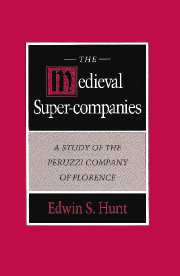Book contents
- Frontmatter
- Contents
- List of tables, figures, and map
- Introduction
- Part I Anatomy of the medieval super-company
- Part II History of the Peruzzi Company from its reorganization in 1300
- 5 The prosperous years, 1300–1324
- 6 The decline begins, 1325–1335
- 7 The critical years, 1335–1340
- 8 The collapse, 1340–1343
- 9 The aftermath
- Conclusions
- Appendixes
- Bibliography
- Index
6 - The decline begins, 1325–1335
Published online by Cambridge University Press: 08 October 2009
- Frontmatter
- Contents
- List of tables, figures, and map
- Introduction
- Part I Anatomy of the medieval super-company
- Part II History of the Peruzzi Company from its reorganization in 1300
- 5 The prosperous years, 1300–1324
- 6 The decline begins, 1325–1335
- 7 The critical years, 1335–1340
- 8 The collapse, 1340–1343
- 9 The aftermath
- Conclusions
- Appendixes
- Bibliography
- Index
Summary
The Fourth Company, formed effective November 1, 1324, marked a distinct change in the fortunes of the business. Its most immediately striking feature was the reduction of capital to almost half the level of the previous company, from li.118,000 to li.60,000. The reduction was not due, as in 1312, to the departure of shareholders, although two did leave the company. One outsider, Bencivenni di Folco Folchi, had died and was not replaced; one Peruzzi, Iacopo di Pacino, left for unknown reasons but was replaced by his brother Donato di Pacino. Most of the decrease by far stemmed from sharp cuts in the capital contributions of virtually all shareholders, including the charity share.
What were the reasons for this dramatic change? Sapori argues persuasively that the main motivation for the lower capital was tax avoidance. The dictator of Lucca, Castruccio Castracani, had culminated months of intrigue in the internal politics of Pistoia with the sudden seizure of that city on May 5, 1325. This alarming event created the need to revive the estimo or wealth tax, abandoned in 1315, to finance a military force to rescue the city. Affluent Florentines were expert at concealing the value of their holdings, but the capital of a company was easy prey for the city authorities to locate and tax.
Sapori says that the shareholders would have been aware in late 1324 of the likely imposition of an estimo and acted accordingly. Here he seems to be assuming that the official establishment and dissolution dates of each company were those on which the actions took place.
- Type
- Chapter
- Information
- The Medieval Super-CompaniesA Study of the Peruzzi Company of Florence, pp. 156 - 183Publisher: Cambridge University PressPrint publication year: 1994



